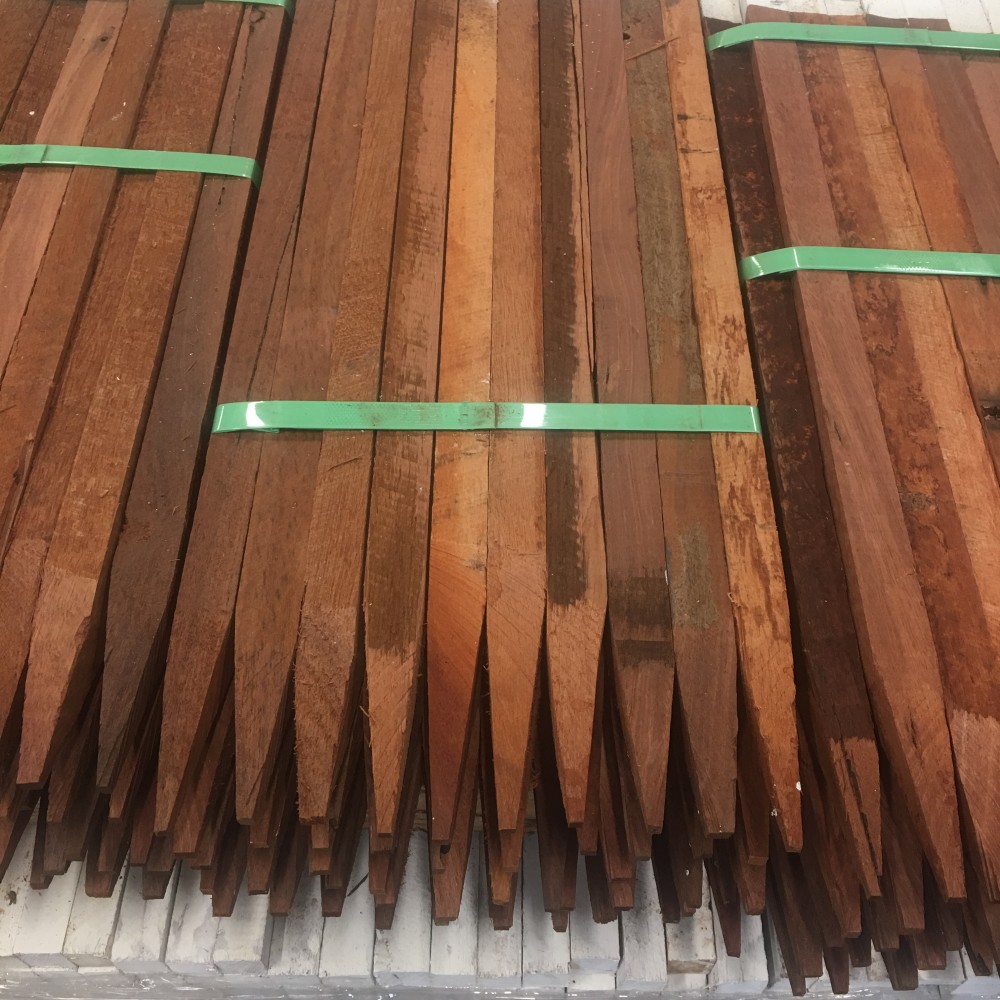When it comes to survey stakes Cody Corporation only provides the highly durable classifications of hardwoods. The secret to survey stakes is making sure to have a hardwood which has very few middle knots or splinting growth lines which cause the survey stakes to splinter, shatter or snap when being hammered into hard ground which is highly common across Australia.
Over the years Cody Corporation has tried and tested many varieties of Hardwood stakes to varying degrees of success. Although the traditional Jarrah Hardwood is very popular it is also highly expensive and tends to have knots quite frequently throughout the stake itself which leads to a higher rate of faulting stakes.
We have come to since learn, test and now trust the Balau Hardwood stakes higher than anything previously used. This is because of the lack of knots the wood generally has and to double up on the strength the wood grain generally runs in a vertical run rather then a typical diagonal run which leads to splintering frequently.
Cody Corporations Hardwood Survey Stakes Supplied marked Below and available for Purchase HERE.
| Timber Species | Strength | Durability Rating |
| Tallowwood | F17 – F34 | Class 1 |
Balau |
F17 – F34 |
Class 1 |
| Ironbark | F22 – F42 | Class 1 |
| Forest Red Gum | F14 – F22 | Class 1 |
| Blue Gum | F14 – F24 | Class 2 |
Jarrah |
F11 – F22 |
Class 2 |
Mahogany |
F11 – F21 |
Class 2 |
| Stringybark | F14 – F22 | Class 3 |
| Oregon (Douglas Fir) | F8 – F14 | Class 3/4 |
The following information will help to decipher how hardwood and softwood stakes, and pegs receive their ratings, determine their lifespan and the pest treatment they receive prior to shipment. Should you be further interested in the specifics of Hardwood click here to read more.
Timber is an organic material with a wide variety of physical and mechanical properties. It is important that a timber species is selected which has the properties suitable for its intended use. The main characteristics that affect the choice are strength, appearance, durability, moisture content (shrinkage rates). Other properties such as density, hardness, fire performance properties etc. will also be important for certain applications.
STRENGTH: Structural timber is graded into categories (stress grades) which can be used to determine member sizes. The stress grade will depend on the natural properties and characteristics of the species (e.g. density, knots, sloping grain).
Stress grades for hardwoods and some softwoods are designated by an ‘F’ number (F5, F14, F17, F27 etc.). Softwoods are also stress graded with an ‘F’ number. ‘F’ grades can be allocated by visual grading, machine stress grading or proof grading.
APPEARANCE: Timber comes in a variety of colours, textures and grains. Timber can also exhibit other natural characteristics such as knots, stains, splits, gum veins which can affect strength properties and aesthetics and a higher stress grade does not automatically ensure a better.
DURABILITY: Durability of timber is the ability to perform its task for a required period. This means its performance when exposed to hazards such as decay (fungi)) and insects (termites and borers). Timber species have different natural durability characteristics. Species are given a durability classification based upon their expected service life in ground or outside above ground and exposed to hazards. In-ground and Above Ground Durability Classes are quite distinct.
The below graph details the classification of Classes of woods corresponding to the woods expected live cycle in ground and above ground.
| Durability Class | Durability Rating | Expected Service Life | |
| In Ground | Above Ground | ||
| 1 | High | 25 | >40 |
| 2 | Reasonably High | 15-25 | 15 to 40 |
| 3 | Moderate | 5-15 | 7 to 15 |
| 4 | Low | <5 | <7 |
TERMITES: Termite management of all buildings shall be in accordance with the National Construction Code (BCA) and where required AS 36601 If termite resistant materials are required, all durability Class 1 and some durability Class 2 timbers have a natural resistance to termites. Softwoods can be preservative treated to H2 (or better).
WEATHERING: If timber is exposed to the weather for an extended period, the surface will discolour (i.e. fade to a silver grey), checks and cracks may form, and the surface becomes rough. Varying degrees of protection from weathering may be provided by the application of coatings such as paints, water repellents, water repellent preservatives and pigmented penetrating stains. The main objective is to prevent or retard the uptake of moisture and the absorption of ultraviolet light.
STRUCTURAL TIMBER: Structural hardwood is usually supplied as a mixture of species, although for speciality applications single species are available. Hardwood can be supplied and used rough sawn and unseasoned, or seasoned which increases in strength, stiffness and stability. Seasoned hardwood is usually sized.
Cody Corporation has a huge range of required surveying stakes in stock at all times of the year at highly competitive prices. should you need something which isn’t something we normally stock please contact us and we will endeavour to source what is required as quickly as possible.
Available Hardwood Sizing of Stakes, Title Pegs and Engineering Pegs at Cody Corporation
| MM | 300 Long | 450 Long | 750 Long | 900 Long | 1500 Long |
| 25 Width | Yes | On Order | Yes | Yes | On order |
| 35 Width | On Order | On Order | On Order | Yes | No |
| 50 Width | Yes | Yes | No | No | No |

